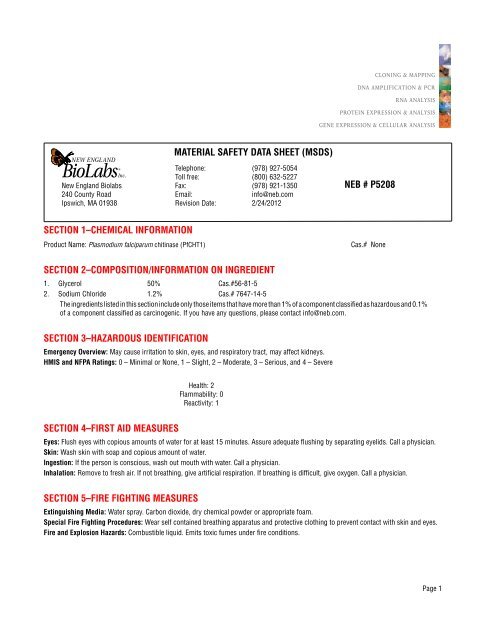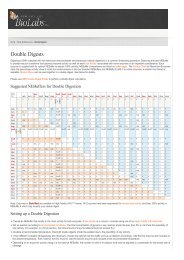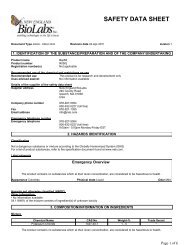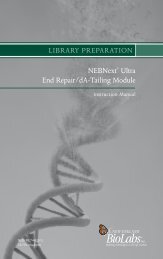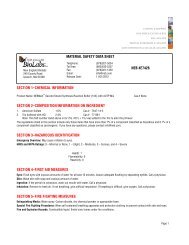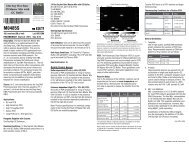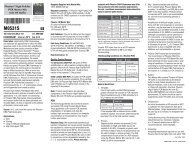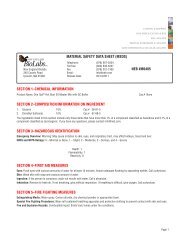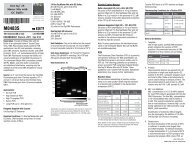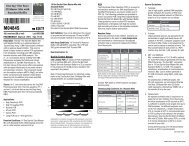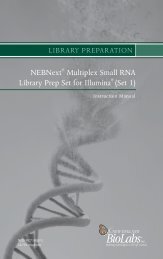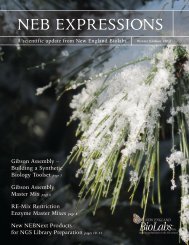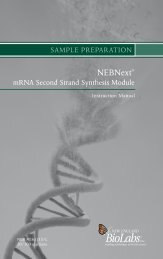Plasmodium falciparum chitinase (PfCHT1) - New England Biolabs
Plasmodium falciparum chitinase (PfCHT1) - New England Biolabs
Plasmodium falciparum chitinase (PfCHT1) - New England Biolabs
Create successful ePaper yourself
Turn your PDF publications into a flip-book with our unique Google optimized e-Paper software.
Cloning & Mapping<br />
DNA Amplification & PCR<br />
RNA Analysis<br />
Protein Expression & Analysis<br />
Gene Expression & Cellular Analysis<br />
NEW ENGLAND<br />
BioLabs®<br />
<strong>New</strong> <strong>England</strong> <strong>Biolabs</strong><br />
240 County Road<br />
Ipswich, MA 01938<br />
Inc.<br />
MATERIAL SAFETY DATA SHEET (MSDS)<br />
Telephone: (978) 927-5054<br />
Toll free: (800) 632-5227<br />
Fax: (978) 921-1350<br />
Email:<br />
info@neb.com<br />
Revision Date: 2/24/2012<br />
NEB # P5208<br />
SECTION 1–CHEMICAL INFORMATION<br />
Product Name: <strong>Plasmodium</strong> <strong>falciparum</strong> <strong>chitinase</strong> (<strong>PfCHT1</strong>)<br />
Cas.# None<br />
SECTION 2–COMPOSITION/INFORMATION ON INGREDIENT<br />
1. Glycerol 50% Cas.# 56-81-5<br />
2. Sodium Chloride 1.2% Cas.# 7647-14-5<br />
The ingredients listed in this section include only those items that have more than 1% of a component classified as hazardous and 0.1%<br />
of a component classified as carcinogenic. If you have any questions, please contact info@neb.com.<br />
SECTION 3–HAZARDOUS IDENTIFICATION<br />
Emergency Overview: May cause irritation to skin, eyes, and respiratory tract, may affect kidneys.<br />
HMIS and NFPA Ratings: 0 – Minimal or None, 1 – Slight, 2 – Moderate, 3 – Serious, and 4 – Severe<br />
Health: 2<br />
Flammability: 0<br />
Reactivity: 1<br />
SECTION 4–FIRST AID MEASURES<br />
Eyes: Flush eyes with copious amounts of water for at least 15 minutes. Assure adequate flushing by separating eyelids. Call a physician.<br />
Skin: Wash skin with soap and copious amount of water.<br />
Ingestion: If the person is conscious, wash out mouth with water. Call a physician.<br />
Inhalation: Remove to fresh air. If not breathing, give artificial respiration. If breathing is difficult, give oxygen. Call a physician.<br />
SECTION 5–FIRE FIGHTING MEASURES<br />
Extinguishing Media: Water spray. Carbon dioxide, dry chemical powder or appropriate foam.<br />
Special Fire Fighting Procedures: Wear self contained breathing apparatus and protective clothing to prevent contact with skin and eyes.<br />
Fire and Explosion Hazards: Combustible liquid. Emits toxic fumes under fire conditions.<br />
Page 1
SECTION 6–ACCIDENTAL RELEASE MEASURES<br />
Personal Precautions: Avoid breathing or contact with vapors, mist of gas.<br />
Environmental Precautions: Do not let product enter drains.<br />
Methods For Cleaning Up: Cover with dry lime, sand, or soda ash. Sweep up and shovel. Place in covered container for disposal.<br />
SECTION 7–HANDLING AND STORAGE<br />
Handling: Provide appropriate exhaust ventilation.<br />
Storage: Keep tightly closed in a dry and well ventilated place. Store at -20°C .<br />
SECTION 8–EXPOSURE CONTROLS/PPE<br />
Engineering Controls: Safety shower and eye wash. Mechanical exhaust.<br />
Personal Protective Equipment:<br />
Eye Protection: Safety goggles.<br />
Hand Protection: Compatible resistant gloves.<br />
Respiratory Protection: None required.<br />
Hygiene Measure: General practice, wash (hands and skin) thoroughly after handling. Remove and wash contaminated clothing.<br />
SECTION 9–PHYSICAL AND CHEMICAL PROPERTIES<br />
Physical State: Form: Liquid Color: Clear or colorless Odor: None or odorless<br />
Property Value Temperature or Pressure<br />
Boiling Point Range: 182°C<br />
Melting Point Range: 20°C<br />
Flash Point:<br />
160°C Method: Closed cup<br />
Auto Ignition Temp: 370°C<br />
Vapor Pressure: < 1 mmHg 20°C<br />
Vapor Density: 3.1 g/l<br />
Specific Gravity: 1.262<br />
Solubility in Water: Soluble<br />
SECTION 10–STABILITY AND REACTIVITY<br />
Stability: Stable under recommended storage conditions.<br />
Materials to Avoid: Acid chlorides, Phosphorus halides, strong oxidizing agents, strong acids, strong reducing agents.<br />
Hazardous Decomposition Products: Carbon monoxide, Carbon dioxide, Sulfur dioxides.<br />
Hazardous Polymerization: Will not occur.<br />
SECTION 11–TOXICOLOGICAL INFORMATION<br />
Acute and Chronic Affects Based On Routes Of Exposure<br />
Eye Contact: May cause irritation.<br />
Skin Contact: May cause irritation.<br />
Ingestion: Low toxicity. May cause nausea, headache or diarrhea.<br />
Inhalation: Unlikely at room temperature, inhalation of mist may cause irritation of respiratory tract.<br />
Chronic Exposure<br />
Target Organ(s): May cause kidney damage.<br />
Aggravation of Pre-existing Conditions: Persons with pre-existing skin disorder or eye problems or impaired liver or kidneys may be more<br />
susceptible to the effects of the material.<br />
NTP: No component of this product present at levels greater than or equal to 0.1% is identified as a known or anticipated carcinogen.<br />
IARC: No component of this product present at levels greater than or equal to 0.1 % is identified as probable, possible or confirmed human<br />
carcinogen.<br />
ACGIH: No component of this product present at levels greater than or equal to 0.1 % is identified as a known or suspected human carcinogen<br />
or confirmed animal with unknown relevance humans.<br />
Page 2<br />
SECTION 12–ECOLOGICAL INFORMATION<br />
No data available.<br />
SECTION 13–DISPOSAL CONSIDERATIONS<br />
Dispose of container, unused contents and contaminated packaging in accordance with federal, state and local requirement. Contract with a<br />
licensed Chemical Waste Disposal Service. Dissolve or mix with a combustible solvent and burn in a chemical incinerator equipped with an<br />
afterburner and scrubber.<br />
SECTION 14–TRANSPORT INFORMATION<br />
This product is not dangerous and no special precautions are needed according to DOT, ADR/RID (cross border), IMDG and IATA/ICAO.<br />
SECTION 15–REGULATORY INFORMATION<br />
OSHA Hazards: None known.<br />
US Classification and Label Test<br />
US Statements: Caution. Avoid contact and inhalation. Target Organ (s): Kidneys.<br />
United States Regulatory Information:<br />
Sara Listed: No<br />
TSCA Inventory Item: Yes<br />
Canada Regulatory Information<br />
WHMIS Classification: This product has been classified in accordance with the hazard criteria of the CPR and the MSDS contains all the<br />
information required by the CPR.<br />
DSL: Yes<br />
NDSL: No<br />
EU Additional Classification<br />
S: 23 24/25<br />
Safety Statements: Do not breath vapor. Avoid contact with skin and eyes.<br />
SECTION 16–OTHER INFORMATION<br />
DISCLAIMER<br />
The information provided on the MSDS is furnished in good faith and based on our present knowledge. However, this MSDS shall not constitute<br />
a guarantee of any kind. Personnel handling this material must make independent determinations of the suitability and completeness of<br />
information from all sources to assure proper use and disposal of this material and the safety and health of employees and customers. NEB<br />
assumes no additional liability or responsibility resulting from the use of, or reliance on this information. This product is for R&D use only.<br />
Not for drug, household or other uses.<br />
Questions about the information found on this MSDS should be directed to info@neb.com.<br />
Page 3


